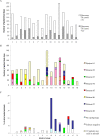The infectiousness of tuberculosis patients coinfected with HIV
- PMID: 18798687
- PMCID: PMC2535657
- DOI: 10.1371/journal.pmed.0050188
The infectiousness of tuberculosis patients coinfected with HIV
Abstract
Background: The current understanding of airborne tuberculosis (TB) transmission is based on classic 1950s studies in which guinea pigs were exposed to air from a tuberculosis ward. Recently we recreated this model in Lima, Perú, and in this paper we report the use of molecular fingerprinting to investigate patient infectiousness in the current era of HIV infection and multidrug-resistant (MDR) TB.
Methods and findings: All air from a mechanically ventilated negative-pressure HIV-TB ward was exhausted over guinea pigs housed in an airborne transmission study facility on the roof. Animals had monthly tuberculin skin tests, and positive reactors were removed for autopsy and organ culture for M. tuberculosis. Temporal exposure patterns, drug susceptibility testing, and DNA fingerprinting of patient and animal TB strains defined infectious TB patients. Relative patient infectiousness was calculated using the Wells-Riley model of airborne infection. Over 505 study days there were 118 ward admissions of 97 HIV-positive pulmonary TB patients. Of 292 exposed guinea pigs, 144 had evidence of TB disease; a further 30 were tuberculin skin test positive only. There was marked variability in patient infectiousness; only 8.5% of 118 ward admissions by TB patients were shown by DNA fingerprinting to have caused 98% of the 125 characterised cases of secondary animal TB. 90% of TB transmission occurred from inadequately treated MDR TB patients. Three highly infectious MDR TB patients produced 226, 52, and 40 airborne infectious units (quanta) per hour.
Conclusions: A small number of inadequately treated MDR TB patients coinfected with HIV were responsible for almost all TB transmission, and some patients were highly infectious. This result highlights the importance of rapid TB drug-susceptibility testing to allow prompt initiation of effective treatment, and environmental control measures to reduce ongoing TB transmission in crowded health care settings. TB infection control must be prioritized in order to prevent health care facilities from disseminating the drug-resistant TB that they are attempting to treat.
Conflict of interest statement
Figures


References
-
- Riley RL, Mills C, O'Grady F, Sultan L, Wittstadt F, et al. Infectiousness of air from a tuberculosis ward. Ultraviolet irradiation of infected air: comparative infectiousness of different patients. Am Rev Respir Dis. 1962;85:511–525. - PubMed
-
- Riley RL, Mills CC, Nyka W, Weinstock N, Storey PB, et al. Aerial Dissemination of pulmonary TB—A two year study of contagion on a tuberculosis ward. Am J Hyg. 1959;70:185–196. - PubMed
-
- Sultan L, Nyka W, Mills C, O'Grady F, Wells W, et al. Tuberculosis disseminators. A study of the variability of aerial infectivity of tuberculous patients. Am Rev Respir Dis. 1960;82:358–369. - PubMed
-
- Rouillon A, Perdrizet S, Parrot R. Transmission of tubercle bacilli: The effects of chemotherapy. Tubercle. 1976;57:275–299. - PubMed

